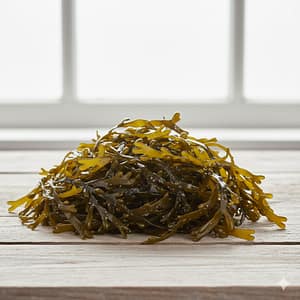- Home
- Rockweed Seaweed (Fucus vesiculosus)

I. General Information
A. Scientific Name:
Fucus vesiculosus
B. Alternative Names:
Rockweed, Bladderwrack, Black tang
C. Pronunciation:
Fyu-kus ve-sik-yoo-lo-sus
II. Sourcing and Origin
A. Source:
Wild-harvested from rocky North Atlantic coasts of Europe and North America.
B. Geographic Origin:
North Atlantic coasts of Europe and North America.
C. Method of Processing:
Harvested, dried, and processed for herbal medicine and extracts.
III. Properties and Uses
A. Physical Properties:
Brown seaweed with air bladders
Tough, leathery texture
Briny aroma
B. Chemical Composition:
Fucoidan, alginates
Iodine, calcium, magnesium
Polyphenols
C. Primary Uses:
Skincare: Used in anti-cellulite creams and toners.
Haircare: Mineral-rich extracts for shampoos.
Wellness: Supports thyroid health and weight management.
Culinary: Traditionally added to soups and broths.
Household: Fertilizer and soil conditioner.
D. Key Benefits:
Natural iodine source for thyroid function
Anti-inflammatory compounds
Rich in antioxidants
IV. Safety and Considerations
A. Potential Allergies:
Iodine sensitivity; not recommended for those with thyroid disorders unless guided.
B. Best Practices for Use:
Often consumed as supplements or herbal teas.
C. Special Precautions:
Avoid overuse due to high iodine content.
V. Fun & Educational Facts
A. Historical Context:
Used in traditional European herbal medicine for thyroid and joint issues.
B. Did You Know?
Rockweed was one of the earliest documented seaweeds in Western medicine.
C. DIY Recipe Idea:
Herbal seaweed tea
Rockweed broth
Nutrient-rich soup base
